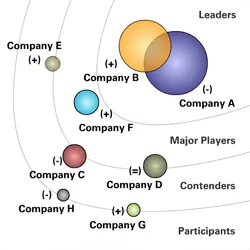You must remember — VC’s are in it to win it. Talk to them with numbers. They have to be able to see the huge market potential and you have to be able to draw an accurate picture.
It’s not just TAM/SAM/SOM – you must be able to tell the market size and your share of it. If it’s small, show them that it’s set to grow and back it up with proof. They want to be excited by the overall opportunity.
And, if you are part of a fast evolving market – what will keep you unique in the value chain when competition strikes?
One More Thing: I’ve been saying for years that this is the silver bullet of your pitch – and now these investors backed me up: Tell them Why now? Why is your product/solution/technology something that’s time has come? What’s the enabling factor? What are the trends pointing towards it? And if you didn’t exist – what trend would still be happening? What is the bigger trend that you are absolutely hooked into?
Understand Their Needs and How You Solve Them
You need to set the stage so they understand your customer, their needs and how your product benefits their needs. In other words, this is the classic problem/solution storytelling, but on a very sophisticated level.
First, draw a picture of the problem and the audience suffering from it – give a few use cases that exemplify why you are needed? Show that you have an in-depth understanding of your customers.
Having a product demo is super important – especially if it’s a great looking product. But you don’t have to explain every point on your product – walk them through the demo from a user perspective with their unique needs and constraints in mind, show off some cool features briefly and mainly focus on the assets and benefits you provide.
One More Thing: If you are in an emerging or highly regulated market where things are still “up in the air” like drones, or “at risk” like InsuraTech, make sure to talk about the regulatory issues, show that you’re familiar with them and what you are doing to address them?
From Concept Fit to Market Fit.
This section was the most eye opening to me – and the most important piece of this article!
According to this group, all early stage VC’s are always imagining your next round – as you’re talking, they’re thinking through the next 18 months and when you’re ready to raise again.
One of the investors said: “Once I write a check – I’m on the hook to help you raise your next Round. Having clarity on what you’re going to achieve in the next 18 months is super important for me to see how you’ll raise your next round and how I’ll onboard the best investors for you.”
If you don’t have recurring revenue, you aren’t VC investable. It doesn’t mean that you aren’t a great company, but VC’s want to see products that have a repeatability of income, something that keeps the money flowing in – not a one time purchase.
Talk about your raise and your metrics: What’s your “proxy for revenue” – meaning what are the numbers for your current DAU, WAU and MAU (Daily, Weekly and Monthly Active Users) and how will that continue to grow and bring in revenues after you raise? And if you have absolute numbers of growth, users, revenues – show them a breakdown, a timeline of how you got there.
What are your allocations for the money you are raising this Round? What’s the pipeline of the product and the marketing strategy? How far will you be when you need to raise your next Round? You don’t have to detail the entire monthly burn rate, but give them an idea of how you will be using the money so they know you’re raising enough to keep you covered till you hit your round objective.
One More Thing: While you don’t necessarily want to spell it out on a slide, you must have a well thought out Exit Strategy. The same investor went on to say: “I need to be able to envision the Act 1, Act 2, Act 3 – where are you going? Even if you fail will you be a nice Exit by then?”
What’s a Show and a No Show?
They said it bores them because everyone has it and it always looks the same, with your company at the top right. One of the VC’s actually said that a company that was pitching them tries to “shake things up” and put their company on the bottom left – and everyone got mad at them.
(This to me proves that people think in schemas and the 2X2 actually has some merit if done right.) If you are going to have it, make sure that the X and the Y are meaningful – not just something like – “affordability and availability.”
When I asked them what alternatives they suggested to show as a visual, there were a few great suggestions:






